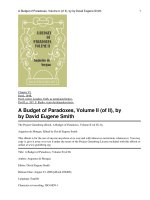optimization of modified volume fresnel zone plate
Bạn đang xem bản rút gọn của tài liệu. Xem và tải ngay bản đầy đủ của tài liệu tại đây (701.83 KB, 8 trang )
Birck Nanotechnology Center
Birck and NCN Publications
Purdue Libraries Year 2009
Optimization of modified volume Fresnel
zone plates
Pornsak Srisungsitthisunti
∗
Okan Ersoy
†
Xianfan Xu
‡
∗
Purdue University,
†
Purdue University - Main Campus,
‡
Birck Nanotechnology Center, School of Materials Engineering, Purdue University,
This paper is posted at Purdue e-Pubs.
/>Optimization of modified volume
Fresnel zone plates
Pornsak Srisungsitthisunti,
1
Okan K. Ersoy,
2,
*
and Xianfan Xu
1
1
School of Mechanical Engineering, Birck Nanotechnology Center, Purdue University, West Lafayette, Indiana 47907
2
School of Electrical and Computer Engineering, Birck Nanotechnology Center, Purdue University,
West Lafayette, Indiana 47907
*
Corresponding author:
Received May 28, 2009; revised July 30, 2009; accepted August 4, 2009;
posted August 4, 2009 (Doc. ID 112072); published September 1, 2009
Modified volume Fresnel zone plates (MVFZPs) fabricated with laser direct writing were optimized for higher
diffraction efficiencies. The Fresnel radii in each layer of a volume zone plate were iteratively adjusted by a
simulation-based direct search optimization. The results show that optimization is effective but depends
strongly on the starting diffraction efficiencies determined by the MVFZP parameters. The simulations indi-
cate that the optimized MVFZP can achieve 93% diffraction efficiency. © 2009 Optical Society of America
OCIS codes: 320.7110, 050.1970, 130.3120, 000.4430
.
1. INTRODUCTION
Recently, modified volume Fresnel zone plates (MVFZPs)
consisting of several layers of Fresnel zone plates have
been developed to improve diffraction efficiency [1]. In our
previous works, we demonstrated high-efficiency
MVFZPs fabricated inside a fused silica by a femtosecond
laser direct writing method [1,2]. The MVFZP replaces
the regular Fresnel zones with central rings [1–3]as
shown in Fig. 1 ,since it is practically convenient to fabri-
cate and provides relatively high diffraction efficiency.
Our fabricated MVFZP achieved a diffraction efficiency as
high as 71% compared with 6% by a single-layer FZP with
the same laser writing condition [2]. Therefore, the
MVFZP approach is highly suitable for laser direct writ-
ing or other methods where the induced phase modula-
tion is limited.
In addition, a beam propagation simulation of MVFZPs
has been developed to provide comprehensive studies of
various designs of MVFZPs [3]. In this paper, the use of
the Hankel beam propagation method (Hankel BPM) is
extended for efficiency optimization of MVFZPs. This ap-
proach is especially useful for optimizing three-
dimensional diffractive optical devices. The motivation
behind MVFZP optimization was that multiple diffrac-
tions occur inside a MVFZP, and it is difficult to directly
design such a device under these complex diffractions [2].
However, the original MVFZP design assumed direct dif-
fraction passing through the subsequent FZP layers ne-
glecting all other diffractions and interferences. As a re-
sult, higher diffraction efficiency can possibly be achieved
by simply changing the positions of the rings such that
more light is diffracted toward a focus spot. For a single-
layer FZP, this would not be possible because the original
Fresnel zones already provide the smallest phase error
for focusing such that the beam is constructively inter-
fered at a focal spot. For the case of MVFZP, the phase
shift is altered by subsequent layers and the original
Fresnel zones in each layer are not necessarily providing
the smallest phase error. Therefore, in this work, MVFZP
optimization is investigated to further improve the dif-
fraction efficiency.
The rest of the paper is organized as follows. The direct
search optimization method suitable for MVFZP simula-
tion is presented in Section 2. Sections 3 and 4 discuss the
results of low-NA and high-NA MVFZP optimizations, re-
spectively. Section 5 studies the influence of the MVFZP
linewidth on the starting efficiency. The sensitivity to fab-
rication errors is analyzed in Section 6 to determine the
accuracy required for fabrication of optimized MVFZPs.
Conclusions are given in Section 7.
2. METHOD
Several algorithms are available for optimization of dif-
fractive optical elements. Input–output optimization algo-
rithms are widely used, including direct binary search,
simulated annealing, and iterative discrete on-axis meth-
ods [4]. Some are based on the iterative Fourier transform
algorithm (IFTA). The well-known IFTA algorithms are
Gerchberg–Saxton, Ping-Pong, Ferwerda, and Yang-Gu
[4]. For multiobjective optimization, evolutionary-based
programming is preferred, such as the genetic algorithm
(GA) [4]. Most of these algorithms optimize results itera-
tively between input and output planes, so they are not
directly applicable for three-dimensional structures.
The direct search optimization is the most straightfor-
ward method to use in simulation-based optimization [5].
Diffraction by MVFZP is calculated by the Hankel BPM,
which utilizes a split-step angular spectrum representa-
tion of plane waves. The direct search method is suitable
in our problem in which a computer simulation is run re-
peatedly in order to compute various quantities needed by
the optimization algorithm. Furthermore, the resulting
simulation output is then postprocessed to arrive at the
2114 J. Opt. Soc. Am. A/ Vol. 26, No. 10 /October 2009 Srisungsitthisunti et al.
1084-7529/09/102114-7/$15.00 © 2009 Optical Society of America
objective value. For example, efficiency calculation cannot
be obtained directly from the Hankel BPM, but it is cal-
culated from the overall intensity distribution at the focal
plane. The direct search method is sometimes the only op-
tion for a complex optimization problem, and usually
guarantees convergence [5].
In optimizing central-ring MVFZPs, there are many pa-
rameters that affect the simulation results, such as focal
length, number of rings (zones), linewidth, and phase
modulation. The diffraction efficiency can be increased by
adjusting any of these parameters. A brief study of these
parameters is available in [3]. It is more meaningful to be
able to optimize diffraction efficiency by designing a bet-
ter MVFZP geometry. In this paper, only the positions of
the rings will be adjusted, while other parameters are
kept fixed. By moving the positions of the rings, the wave-
front is modified and diffracted through multiple layers of
MVFZP. Clearly, the rings can be adjusted in either radial
or axial direction or both. We decided to adjust the
MVFZP rings only in the radial direction to maintain the
layered structure for ease of fabrication.
A direct search algorithm is used to optimize the ring
positions to provide highest diffraction efficiency. Before
optimization, the original locations of the rings follow the
Fresnel zone plate equation for central-ring radii given by
r
n
=
ͱ
͑2n +1͒f
2
+
ͩ
͑2n +1͒
4
ͪ
2
; n =1,2,3, , ͑1͒
where f is the focal distance relative to the layer, is the
wavelength, and n is the ring number. It is expected that
by starting with the Fresnel equation, the solution should
converge much faster. In each iteration, a ring is ran-
domly selected from any layer of the MVFZP. Then, the
radial position is adjusted by a small step in both inward
and outward directions. The two cases are treated sepa-
rately. If the adjusted position improves the diffraction ef-
ficiency, the new radius is stored for further evaluation.
The position adjustment is terminated as soon as the dif-
fraction efficiency stops increasing. Finally, the new radii
of the inward and outward cases are compared, and the
one with higher efficiency is saved. This is a completion of
one iteration before randomly selecting the next ring. The
diagram for one iteration of this algorithm is shown in
Fig. 2. Diffraction efficiency is defined by the percentage
of light collected within the focal region over the total in-
cident light. We define the focal plane as the plane where
the maximum light intensity occurs and the focal spot di-
ameter is equal to d =1.22ء / NA, given by Rayleigh’s cri-
terion.
Within one iteration, several recalculations of the Han-
kel BPM are possibly involved. The direct search algo-
rithm always guarantees convergence, and its accuracy
depends on the number of sampling points used. How-
ever, a high number of sampling points can lead to a con-
siderably long computational time. As a default, 1500 ra-
dial steps and 500 axial steps were used in most MVFZP
simulations, which took 21 s per iteration on a 2.0 GHz
computer. On the average, using this default resolution,
optimization with 1000 iterations was completed in six to
eight hours. Using the same algorithm, other quantities
can be optimized such as intensity at any location, depth
of focus, etc.
3. OPTIMIZATION OF LOW-NA MVFZPS
In this section, optimization of low numerical aperture
(NA) MVFZPs is investigated. Previously, the low NA
MVFZPs fabricated inside fused silica achieved a diffrac-
tion efficiency of 71% [2]. Our optimization simulations
were carried out with three different focal lengths: 10 mm
͑NA=0.037͒,20mm͑NA=0.026͒, and 30 mm ͑NA
=0.021͒. They had the same parameters for eight layers,
ten Fresnel rings (zones) for each layer, 10
m central-
ring width, and phase modulation of 0.23
at each layer.
The MVFZPs were designed for the He–Ne laser wave-
length, 632.8 nm. These parameters were previously used
in femtosecond laser direct writing experiments [1,2].
During optimization, peak intensity and diffraction effi-
ciency were monitored. The peak intensity corresponds to
the highest intensity near the focal point. The passing
conditions for the storage of each iteration result can be
either higher efficiency or higher peak intensity, or both.
In this algorithm, the peak intensity was not limited to
being located at exactly the design focal length in order to
achieve the highest intensity, but it was always very close
to it. However, if the exact focal length is critical, the al-
gorithm can be changed to monitor the peak intensity
Fig. 1. Comparing the geometry of (a) regular FZP and (b)
central-ring FZP. The central-ring FZP has a uniform-linewidth
rings located on the middle of the Fresnel zones.
Fig. 2. Direct search algorithm for diffraction efficiency optimi-
zation. This is a single iteration including both directions of ra-
dius adjustment.
Srisungsitthisunti et al. Vol. 26, No. 10 /October 2009/J. Opt. Soc. Am. A 2115
only at the focal length. The optimization results for the
first 1000 iterations are shown in Fig. 3 for peak intensi-
ties and their corresponding efficiencies.
In general, all iterations were observed to converge
within the first 1000 iterations. The results suggest that
the improvements of diffraction efficiency and peak inten-
sity are directly related. The central-ring MVFZPs had
different starting diffraction efficiencies of 77.7%, 53.7%,
and 31.7% for MVFZPs with focal length of 10 mm,
20 mm and 30 mm, respectively. The uniform linewidth
strongly influenced the starting efficiencies of these
MVFZPs. The selected linewidth determines how closely
the Fresnel zones are approximated by uniform central-
ring zones. The 10
m linewidth was best fit for the
10 mm focal length MVFZP, and a larger linewidth is pre-
ferred for a MVFZP with longer focal length. The opti-
mized efficiencies were 92.7%, 71.0%, and 48.9% for
MVFZPs with focal lengths of 10 mm, 20 mm and 30 mm,
respectively. As such, the efficiency improved by 19.4%,
32.2%, and 54.0% for MVFZPs with focal lengths of
10 mm, 20 mm, and 30 mm, respectively, with the same
initial conditions. Therefore, optimization was more effec-
tive with MVFZPs with lower starting efficiencies. During
optimization, it was found that the MVFZP rings were ad-
justed only slightly in order to significantly improve dif-
fraction efficiency. For instance, the optimized MVFZP of
20 mm focal length had an average ring position shift of
2.9
m. Therefore, high efficiency is very sensitive to the
positions of the rings. As a related topic, we investigate
the effect of position errors on difraction efficiency in Sec-
tion 5.
To show the details of how the optimization algorithm
changes the output light distribution of a MVFZP, Fig. 4
compares the normal MVFZP output and optimized
MVFZP output for the 20 mm MVFZP. Optimization was
observed to have slight effects on the FWHM and the
depth of focus (DOF) of the beam. The higher-order foci
appeared to be suppressed by optimization, especially
with the second order. We believe that this suppression is
due to the randomness of the rings which breaks the sym-
metry required for higher-order foci. Suppression of
higher-order foci with a modified FZP by using a nonuni-
form zone-width-to-radius ratio was also reported in [6].
4. OPTIMIZATION OF HIGH-NA
MVFZPS
High-NA MVFZPs are significant in high-resolution ap-
plications, but they were previously subject to low diffrac-
tion efficiencies. To demonstrate the diffraction efficiency
improvement of high-NA MVFZPs, we optimized three
MVFZPs having focal length of 10
m ͑NA=0.82͒,20
m
͑NA=0.67͒, and 30
m ͑NA=0.58͒. Other parameters
were kept constant as follows: eight layers of zone plates,
ten rings, central-ring width of 1
m, and phase modula-
tion of 0.23
. The MVFZPs were designed for the He–Ne
laser wavelength at 632.8 nm. The simulation results are
shown in Fig. 5. The simulations showed that the
higher-NA MVFZPs typically have lower efficiencies and
lower peak intensities. In general, high-NA MVFZPs per-
form relatively poorly because it is more difficult to dif-
fract light at a larger angle. However, the optimized
MVFZP with 10
m focal length significantly improved
its efficiency from 12.1% to 20.1%. The 20
m MVFZP’s
efficiency increased from 32.0% to 60.1%, and 30
m
high-NA MVFZP’s efficiency increased from 52.3% to
Fig. 3. (a) Peak intensities and (b) their corresponding diffrac-
tion efficiencies of low NA MVFZP optimizations during the first
1000 iterations. Three low NA MVFZP were simulated: f
=10 mm ͑NA=0.037͒, f=20 mm ͑NA=0.026͒, and f =30 mm ͑ NA
=0.021͒.
0 5 10 15 20 25 30 35 4
0
0
1000
2000
3000
Axial Distance (mm)
Intensity
-50 -40 -30 -20 -10 0 10 20 30 40 5
0
5
0
0
1000
2000
3000
Radial Distance
(
um
)
Intensity
Normal
Optimized
Fig. 4. Optimized result of a low NA MVFZP with a focal length
of 20 mm ͑NA=0.026͒.
2116 J. Opt. Soc. Am. A/ Vol. 26, No. 10 /October 2009 Srisungsitthisunti et al.
77.3%. These results indicate that optimization is effec-
tive in increasing diffraction efficiencies, especially when
the starting efficiencies are low. High-NA MVFZPs with
initial high efficiencies could not improve much further,
whereas the low efficiency MVFZPs could double their ef-
ficiencies. In an additional test, the MVFZP with NA
=0.92 showed efficiency improvement from 7.2% to 15.6%.
Similar to low-NA MVFZP results, the linewidth plays an
important role on determining the starting efficiency. A
1
m linewidth seemed to be best fit for the focal length of
30
m or larger. The zone width of a regular FZP de-
creases nonlinearly from center to outer zones, but the av-
erage width of the first ten zones for FZPs with 10
m,
20
m, and 30
m focal lengths are 0.56
m, 0.73
m,
and 0.87
m, respectively. Hence, it is not surprising that
the 1
m linewidth is more efficient for the MVFZP with
30
m focal length. Nevertheless, this average linewidth
estimation should not be applied to low-NA MVFZPs since
the zone width of a regular low-NA FZP decreases much
more rapidly. The average width of the first ten zones for
regular FZPs with 10 mm, 20 mm, and 30 mm focal
lengths are 4.7
m, 6.7
m, and 26.0
m, respectively.
The standard deviations of the average zone widths of
low-NA FZPs are much higher than those of the high-NA
FZPs, and the optimal linewidth cannot be estimated
from the average linewidth. For high-NA MVFZP, the
rings were finely adjusted and the optimized MVFZP of
20
m focal length had an average ring position shift of
only 0.16
m.
Figure 6 displays the light distribution for high-NA
MVFZPs before and after optimization. Even though the
rings are designed for 20
m focal length, the focus was
shifted toward the MVFZP by 4.6
m. The similar focal
shift and higher-order foci suppression were observed in
simulation results of near-field zone plates [7]. Our finite-
difference time-domain (FDTD) simulations also evi-
denced a focal shift of the near-field FZP (not shown in
this paper). These observations indicate that the Fresnel
equation is not very accurate in the near-field region. To
accurately design a near-field MVFZP, evanescent waves
and/or surface plasmons must be considered. Comparing
between the original and the optimized MVFZP, the focal
shift during optimization is relatively small. In addition
to the focal shift, the higher-order foci of these MVFZPs
were suppressed.
5. EFFECT OF LINEWIDTH ON
DIFFRACTION EFFICIENCY
In Section 4 the optimizations of MVFZPs were investi-
gated based on the experimental parameters. In this con-
nection, the linewidths for low-NA and high-NA MVFZPs
were chosen as 10
m and 1
m, respectively. In this sec-
tion, the influence of linewidth on starting efficiency and
optimization is further investigated. Figure 7 compares
MVFZPs having the same focal length of 20 mm and vari-
ous linewidths from 2
mto20
m. For a small line-
width, the optimization is not effective since only a small
portion of light is diffracted by the MVFZP no matter how
the rings are adjusted. A large linewidth is expected to
suffer from low diffraction resulting in a small efficiency
increase during optimization. The optimal linewidth pro-
vides conditions for effective optimization. In fact, optimi-
zation works well when the linewidth is not too far from
the optimal range.
Fig. 5. (a) Peak intensities and (b) their corresponding diffrac-
tion efficiencies with high NA MVFZP optimizations during the
first 1000 iterations. Three high NA MVFZP were simulated: f
=10
m ͑NA=0.82͒, f=20
m ͑NA=0.67͒, and f=30
m ͑NA
=0.58͒.
0 5 10 15 20 25 30 35 40
0
500
1000
1500
200
0
Axial Distance (um)
I
ntens
i
ty
-3 -2 -1 0 1 2 3
0
500
1000
1500
2000
Radial Distance (um)
I
ntens
i
ty
Normal
Optimized
Fig. 6. Optimized result of a high NA MVFZP with a focal
lengthof20
m (NA0.67).
Srisungsitthisunti et al. Vol. 26, No. 10 /October 2009/J. Opt. Soc. Am. A 2117
To estimate the optimal linewidth at different focal
lengths, we calculated low-NA MVFZP efficiencies for dif-
ferent combinations of linewidth and focal length before
optimization, as shown in Fig. 8. The results indicate a
single high-efficiency region concentrated around 10
m
linewidth at 10 mm focal length. This confirms that an
optimal linewidth exists and significantly influences opti-
mization at a focal length below 25 mm. Without optimi-
zation, the MVFZPs can provide efficiency more than 84%
for certain parameters (for example, 4 mm focal length
and 6
m linewidth). However, in practice, a MVFZP is
designed at arbitrary focal length and the experimental
linewidth is not completely controllable. Therefore, opti-
mization is needed to improve the efficiency and allows
more flexible MVFZP design. Similarly, the optimal line-
width was studied for high-NA MVFZP, and the result is
shown in Fig. 9. The optimal linewidth is around 0.7
m
for focal length in the range of 10–50
m.
In addition, two optimizations of different combina-
tions with similar starting efficiencies are compared. The
two combinations include 21 mm focal length with 16
m
linewidth and 16 mm focal length with 7
m linewidth.
Both MVFZPs have starting efficiency around 54%, and
the optimization results are shown in Fig. 10. The results
show different optimization capabilities. The 21 mm focal
length showed an efficiency increase to 79%, while the
16 mm focal length showed an efficiency increase to 63%.
This implies that the optimized efficiency is independent
of the starting efficiency and is difficult to estimate with-
out optimization.
6. STUDY OF SENSITIVITY TO
FABRICATION ERRORS
In practice, there are experimental errors in laser direct
writing of MVFZPs due to machine accuracy, fluctuation
in laser source, external disruptions, etc. By investigating
the effects of fabrication errors, one can understand the
error tolerances of the optimized MVFZP designs. The
fabrication errors can be generated in axial and radial di-
rections. In sensitivity studies to be reported, the given
error was added to the radial or axial position of the op-
timized MVFZP. Each ring was randomly modified with
the given error; then, the modified diffraction efficiency
was calculated. We investigated the effects of fabrication
errors for low-NA and high-NA MVFZPs separately. Since
the introduced errors are random, each result was ob-
tained by averaging over 5–10 trials.
The effects of errors on low-NA and high-NA MVFZPs
are shown in Figs. 11 and 12, respectively. For the
MVFZP with NA=0.026, the efficiency started to drop
Fig. 7. Optimization of MVFZP having 20 mm focal length with
different linewidth ranging from 2
mto20
m.
Fig. 8. Diffraction efficiencies before optimization with various
focal lengths and linewidths for low NA MVFZP.
Fig. 9. Diffraction efficiencies before optimization with various
focal lengths and linewidths for high NA MVFZP.
Fig. 10. Optimization of two linewidth and focal length combi-
nations that have similar starting efficiency.
2118 J. Opt. Soc. Am. A/ Vol. 26, No. 10 /October 2009 Srisungsitthisunti et al.
about 10% when the axial error was greater than 90
m
and the radial error was greater than 1
m. On the other
hand, the MVFZP with NA=0.67 tolerated axial error of
only 300 nm and radial error of 100 nm for approximately
10% efficiency decrease. For both cases, the radial error is
more critical than the axial error for optimized MVFZPs.
In laser direct writing fabrication, the lateral accuracy
depends on the stage accuracy, and the axial accuracy de-
pends on the focal depth of the writing laser. The accuracy
of radial position is approximately 1
m with our air
bearing linear stage (Aerotech). This accuracy is sufficient
for fabrication of low-NA MVFZPs but not for fabrication
of high-NA MVFZPs. The high-NA MVFZP requires piezo
stages to achieve submicrometer resolution. The actual
axial position is somewhat difficult to specify since the fo-
cus spot is elongated inside a transparent material due to
spherical aberration [8]. As a result, the elongated focus
spot induces additional error in the axial direction.
Finally, the effect of error in phase modulation was
analyzed, and the result is shown in Fig. 13. The MVFZPs
used in this study were optimized at 0.23
phase modu-
lation, but the highest efficiency occurred around 0.26
.
This is unexpected but implies that the optimized condi-
tion also performs well for a slightly higher phase modu-
lation. The efficiency curves show unsymmetrical shape,
and the negative phase error has larger efficiency reduc-
tion compared to positive phase error. In either case, the
phase error of 0.05
results in efficiency drop within 10%.
Phase error is directly related to the thickness of the FZP
layer. Therefore, the phase error of 0.05
is equivalent to
about 15
m of thickness error (at =633 nm and ⌬n
=0.001), which is relatively large. In other words, the
phase error is much less sensitive compared with the
axial positional error.
7. CONCLUSIONS
The direct search optimization of MVFZPs was investi-
gated. The approach has shown considerable improve-
ment in diffraction efficiency over original MVFZP design.
The algorithm used in our direct search optimization is
straightforward, and all simulations converged relatively
fast. The efficiency increase strongly depended on the
starting efficiency, which is controlled by the MVFZP pa-
rameters, especially linewidth. Thus, it is important to se-
lect a linewidth close to the optimal linewidth to have a
high starting efficiency and effective optimization. In
practice, for femtosecond laser direct writing fabrication,
many parameters are not completely flexible, such as in-
dex change, laser induced cross section, etc. Under these
limited conditions, the direct search optimization becomes
truly useful. It is able to optimize for the most efficient de-
sign under given constraints.
The optimized low-NA MVFZP was shown to achieve
maximum diffraction efficiency of 93%, improved from a
diffraction efficiency of 71% for the original design. The
high-NA MVFZP efficiencies also improved significantly.
Optimized MVFZP was achieved with only slight ring po-
sition shifts from the original design with no difference in
fabrication time, cost, complications, etc. The gained effi-
ciency is due to change in geometry. The sensitivity stud-
ies showed that the optimized low-NA MVFZP is robust
against fabrication errors. However, the optimized
Fig. 11. Fabrication error simulations of low NA MVFZP ͑NA
=0.026͒.
Fig. 12. Fabrication error simulations of high NA MVFZP ͑NA
=0.67͒.
Fig. 13. Phase error simulations of low and high NA MVFZPs.
Srisungsitthisunti et al. Vol. 26, No. 10 /October 2009/J. Opt. Soc. Am. A 2119
high-NA MVFZP requires more accurate fabrication tech-
nology, and the allowable error is within 100 nm. In the
future, MVFZP will be optimized for smaller focal spots
while maintaining high efficiencies. This multiobjective
optimization is also possible with a similar approach.
ACKNOWLEDGMENT
The authors gratefully acknowledge the funding provided
by the Nanoscale Interdisciplinary Research Teams
(NIRT) program of the National Science Foundation
(NSF) under contract NIRT-0707817.
REFERENCES
1. P. Srisungsitthisunti, O. K. Ersoy, and X. Xu, “Volume
Fresnel zone plates fabricated by femtosecond laser direct
writing,” Appl. Phys. Lett. 90, 011104 (2007).
2. P. Srisungsitthisunti, O. K. Ersoy, and X. Xu, “Laser direct
writing of volume modified Fresnel zone plates,” J. Opt.
Soc. Am. B 24, 2090–2096 (2007).
3. P. Srisungsitthisunti, O. K. Ersoy, and X. Xu, “Beam
propagation modeling of modified volume Fresnel zone
plates fabricated by femtosecond laser direct writing,” J.
Opt. Soc. Am. A 26, 188–194 (2009).
4. B. Kress and P. Meyrueis, Digital Diffractive Optics: An
Introduction to Planar Diffractive Optics and Related
Technology (Wiley, 2000).
5. T. G. Kolda, R. M. Lewis, and V. Torczon, “Optimization by
direct search: new perspectives on some classical and
modern methods,” SIAM Rev. 45, 385–482 (2004).
6. Q. Cao and J. Jahns, “Modified Fresnel zone plates that
produce sharp Gaussian focal spots,” J. Opt. Soc. Am. A 20,
1576–1581 (2003).
7. R. G. Mote, S. F. Yu, B. K. Ng, W. Zhou, and S. P. Lau,
“Near-field focusing properties of zone plates in visible
regime—New insights,” Opt. Express 16, 9554–9564
(2008).
8. N. Huot, R. Stoian, A. Mermillod-Blondin, C. Mauclair, and
E. Audouard, “Analysis of the effects of spherical
aberration on ultrafast laser-induced refractive index
variation in glass,” Opt. Express 15, 12395–12408 (2007).
2120 J. Opt. Soc. Am. A/Vol. 26, No. 10 /October 2009 Srisungsitthisunti et al.









